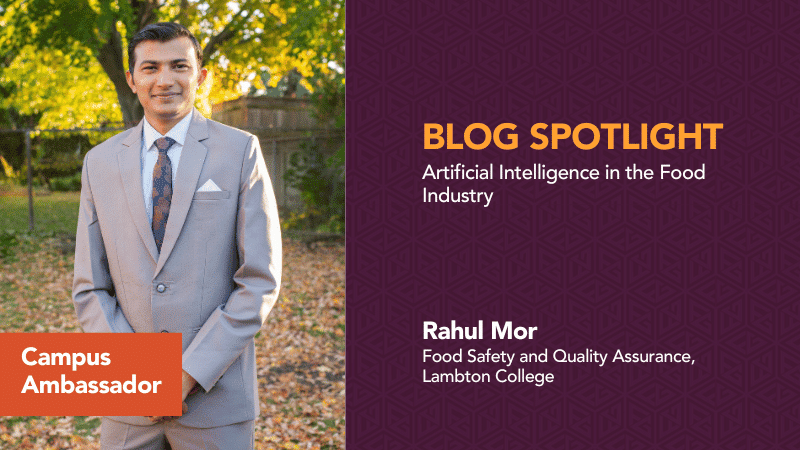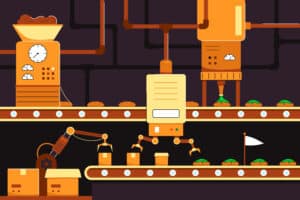Artificial Intelligence in the Food Industry
Last Updated on October 27, 2024
Working in the pharmaceutical industry for two years gave me a lot of insight into how technology can make a difference in safety and efficiency. During my time there, I saw how Artificial Intelligence (AI) became a powerful tool that changed the way we worked. Now, as I’m transitioning into the food safety space, I can’t help but think about how the same AI systems could enhance food safety, making it faster and more accurate.
My Experience with AI in Pharmaceuticals:
When I first started in the pharmaceutical industry, I had no idea how much AI would influence our work. One of the most impressive systems we used was a predictive maintenance AI. It constantly monitored our machines for signs of wear or malfunction. This wasn’t just about convenience—it helped prevent breakdowns that could have led to significant delays or worse, product contamination. The AI could detect tiny changes in vibration or temperature that would go unnoticed by the human eye, allowing us to address issues before they became bigger problems.
Another example of AI that I worked closely with was in automated quality control. We used the Cognex Vision System, an AI-powered camera (figure 1) that inspected every single product as it came down the production line. Imagine trying to manually check hundreds of pills or packages per minute—it’s impossible. But the AI system did it effortlessly, spotting even the smallest defects, like tiny scratches or misaligned labels. It gave us the confidence that every product leaving the facility was up to our strict quality standards.
AI’s Potential in the Food Industry
Seeing how AI transformed our pharmaceutical processes made me think about its potential in food safety. Just like in the pharma world, food production requires meticulous attention to detail, and one small error can have major consequences for consumer health.
Predictive Maintenance for Food Production
- In food manufacturing, keeping machines like ovens, refrigerators, and processing equipment in top condition is crucial. AI can monitor these systems, just as it did in pharma, ensuring they run smoothly and alerting operators when there’s a potential problem. This can prevent costly breakdowns and even contamination risks caused by malfunctioning equipment.
- Imagine using AI to inspect every single fruit, vegetable or package of meat on a production line, just like it did with pharmaceutical products. Systems like Cognex can be adapted to food processing, helping companies detect defects like bruised fruits or improperly sealed packages. With AI’s precision, nothing slips through the cracks.
Supply Chain Tracking
- One of the biggest challenges in food safety is tracing products from farm to table. AI can analyze vast amounts of data across the entire supply chain, flagging potential contamination risks, optimizing storage conditions, and ensuring traceability at every stage. This helps companies react faster in the event of a foodborne illness outbreak.
For example, many food manufacturing companies use IBM Watson’s AI capabilities to enhance food safety and quality assurance. By analyzing vast amounts of data from various sources, including production lines and supply chain logistics, Watson can identify patterns and anomalies that may indicate potential safety issues or quality deviations.
Food and beverage industry automation through robotics
- Automated Packaging Robots: Robots designed for packaging can automate tasks such as filling, sealing, labeling, and palletizing products. They can handle various types of packaging materials and adapt to different product sizes and shapes.
- Cobots (Collaborative Robots): Collaborative robots work alongside human workers to assist in tasks such as assembly, picking, and packing. They are designed to be safe and easy to use, requiring minimal safety barriers.
- Robotic Inspection and Quality Control: Robots equipped with vision systems (like, Cognex) can automate the inspection process for quality control. These robots can identify defects, check for proper labelling, and ensure that products meet safety standards.
Image by Freepix.com
Drawbacks of AI in Food Safety
As much as I’ve seen the benefits of AI, it’s important to acknowledge that it’s not a perfect solution, especially in food safety. There are still a few significant challenges we need to address.
Initial Investment Costs
Implementing AI systems is expensive. For smaller food manufacturers, the cost of installing AI-driven machines and training employees can be prohibitive. This can slow down the adoption of AI, even though the long-term benefits might outweigh the initial expense.
Data Security Risks
AI systems rely heavily on data collection and analysis. This brings up concerns about the security of that data. For instance, hackers could target AI systems in the supply chain, leading to potential disruptions or breaches of sensitive information.
Job Loss Concerns
One of the biggest fears surrounding AI is that it will replace human jobs. In the food industry, where a lot of work involves repetitive tasks, there’s a risk that AI could take over these roles. However, I believe that AI can also create new opportunities, like managing and maintaining these advanced systems.
Reliability Issues
While AI is powerful, it’s still not perfect. Over-reliance on technology can lead to problems if the systems malfunction. In industries like food safety, human oversight is still essential to ensure everything runs smoothly.
My Forecast on Future of AI Forecast
AI is going to change the food industry in big ways, making it safer, faster, and more sustainable. It will help create personalized food options based on individual health needs. AI will improve food safety by monitoring products in real-time and checking for quality automatically.
In factories, robots will take over tasks like preparing and packaging food, making things quicker and more accurate. AI will also improve how food moves through the supply chain, reducing waste and improving tracking. It will help farmers grow crops more efficiently and speed up new food product development. Overall, AI will make food production smarter and more customer-friendly.
Conclusion
From my experience in pharmaceuticals, I’ve seen how AI can enhance productivity and ensure higher levels of quality and safety. This technology, when applied to the food industry, has the potential to make food production faster, safer, and more efficient. However, we need to keep in mind the challenges—like costs, security, and the human factor—when considering widespread AI adoption in food safety.





leave your comment